|
Fall Calving: Who Has A Marketing Plan?
DR. ANDREW P. GRIFFITH
KNOXVILLE, TENN.
The fall calving season is in full swing and many fall calving herds will be wrapping up the calving season by the end of November. For many producers, their thoughts rest on winter feeding and trying to keep cattle healthy. Winter feeding and cattle health are important but so is the marketing plan for those calves. The marketing plan should start early and be evaluated regularly. The health and growth characteristics of those animals from birth through marketing have large implications on the profitability of those animals.
Several factors related to cattle marketing should be considered and evaluated over the next several months and they may include but are not limited to:
1. Marketing methods available;
2. Production practices necessary to participate in the aforementioned marketing alternatives;
3. Target market weight/target market date;
4. Seasonality of cattle prices;
5. Price risk management.
The reason for evaluating marketing factors early and often is to maximize the value of the cattle being produced while also managing certain risks experienced in cattle production and marketing. Some marketing methods are available every day while other marketing methods may only be available once a week, once a month, or seasonally. Producers should make themselves aware of all the marketing alternatives available to them and then determine the dates in which sales occur. Marketing alternatives may include private treaty, weekly auction market, feeder calf sale, marketing alliance, video sale, retained ownership, or some other method.
Some marketing methods and venues require certain production practices be performed in order for cattle to be marketed through the sale. Management practices that may be required include calves being weaned, vaccinated, castrated, dehorned, or some other management practice. These practices are meant to reduce the risk to the buyer which should increase the price received by the seller. The marketing methods that most often require additional management or are most often used when providing additional management include marketing alliance sales, special feeder calf sales, and video sales. There are times when cattle receiving additional management are marketed through other venues such as the weekly auction market and often times those better managed cattle receive a higher price than cattle being marketed with less management.
Oftentimes, producers market calves and feeder cattle based on a target weight or target date. The target weight and/or date may be the weight and/or date producers try to sell cattle every year. However, production practices starting from birth can influence when an animal reaches a certain target weight on a specific date and thus impacts the value of the animal. The marketing decision should take into account seasonality of prices. Cattle prices generally follow a seasonal trend as is shown in the figure entitled ‘Seasonal Cattle Price Index for M-1 Steers at Tennessee Auctions, 2005-2014.’ Understanding how cattle prices seasonally change can help producers choose a marketing weight and date to increase the overall sale value of an animal.
Another marketing tool producers should consider when planning the marketing of calves and feeder cattle is price risk management. Price risk management tools may include livestock risk protection insurance, futures contract, options contract, forward contract, or some other arrangement. Starting today and going to the time period in which producers market their cattle, prices could increase, decrease or stay the same. If prices increase or stay the same then price risk management will likely cost more than what it is worth. However, if prices decline much like they did this fall then there could be several dollars that producers never capture due to the price decline. Prices do not always decline, but when they do, I receive more phone calls.
Producers are encouraged to begin evaluating cattle marketing strategies earlier rather than later. Production practices will impact many of the marketing decisions and the failure to perform a certain production practice could eliminate a marketing alternative. There is nothing wrong with choosing one marketing alternative over another, but there is no reason to be eliminated from a marketing alternative because of failure to manage the cattle appropriately. ∆
DR. ANDREW P. GRIFFITH: Assistant Professor, Agricultural and Resource Economics, University of Tennessee

|
|